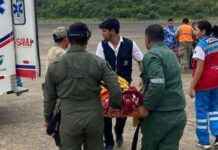For several days, clashes with heavy weapons have been reported near Kibumba, about twenty km north of Goma. This locality is considered one of the last locks on the national road 2 towards the capital of North Kivu.
In the early afternoon, amid rumors of a rebel advance, soldiers were seen passing on motorbikes near the Kanyaruchinya IDP camp, south of Kibumba.
Since the advance of the M23 in the province, thousands of inhabitants have taken refuge in this camp to escape the fighting. On Monday, the head of the camp estimated the number of its occupants at around 40,000.
The displaced “saw soldiers fleeing on motorcycles, which triggered” a movement of panic, a displaced person who fled to Goma told AFP. “Soldiers fled after the fighting and the population, including displaced people, also fled,” confirmed a security source, on condition of anonymity.
“I want to reassure you… The loyalist forces contain the enemy on the heights of Kibumba”, declared to the press at the end of the day the military governor of North Kivu, General Constant Ndima, asking the population to “keep calm”.
A former Tutsi rebellion, the M23 (March 23 Movement) took up arms again at the end of last year.
Kinshasa accuses Kigali of providing support to this rebellion that UN experts and American officials have also pointed out in recent months. Kigali disputes, accusing in return Kinshasa, which also denies, of collusion with the FDLR, Rwandan Hutu rebels established in the DRC since the genocide of the Tutsi in 1994 in Rwanda.
– “De-escalation” –
In an attempt to ease tensions in the region, plagued for almost 30 years by violence from armed groups, including the M23, several diplomatic initiatives have been launched, in particular by the Community of East African States (EAC ).
The latter decided to deploy a regional force and planned to organize a new session of peace talks in Nairobi on 21 November. To prepare them, the “facilitator” she appointed, Uhuru Kenyatta, stayed two days in Kinshasa and spent Tuesday afternoon in Goma.
He himself went to the Kanyaruchinya camp. “I can’t ignore what I saw,” he said in a statement to the press in Goma, adding that he had heard “heartbreaking” stories.
“I say this to all parties: you cannot negotiate in the face of a human catastrophe,” he added.
The day before in Kinshasa, he had called on the armed groups to “lay down their arms”, adding to the address of the groups of foreign inspiration that they had to understand that “the DRC is no longer the battlefield for problems which are not from this country”.
From the start of a previous session of consultations, in April in the Kenyan capital, fighting had resumed between the army and the M23. The DRC government has since refused to discuss with the M23, which it describes as a “terrorist” movement supported by Rwanda.
US Secretary of State Antony Blinken, who already in August had judged information on Kigali’s support for M23 “credible”, renewed the pressure during a meeting with Rwandan Minister of Foreign Affairs Vincent Biruta on the sidelines of the summit. of the G20 in Bali.
“I underscored the deep concern of the United States about the continuing violence in eastern DRC and called on Rwanda to act to facilitate de-escalation,” Antony Blinken wrote on Twitter after the meeting.
On the same social network, Vincent Biruta said he reiterated to him “Rwanda’s commitment” to seek “peace and stability” in eastern DRC and underlined “the need for all parties to work to a political solution to the crisis”.








